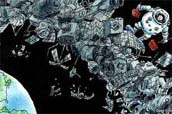Scientists are increasingly worried about the amount of debris orbiting the Earth, writes Dr K.H. Amin
 February 10th 2009 began like every other day in Iridium 33’s 11-year life. One of a constellation of 66 small satellites in orbit around the Earth, it spent its time whizzing through space, diligently shuttling signals to and from satellite phones. At 3pm a report suggested it might see some excitement: two hours later it would pass less than 600 metres from a defunct communications satellite called Cosmos 2251. It did. A lot less. The two craft collided and the result was hundreds of pieces of shrapnel more than 10cm across, and thus large enough to track by radar-and goodness knows how many that were not. This accident came two years after the deliberate destruction by the Chinese of their Fengyun-1C spacecraft in the test of an anti-satellite weapon. That created over 2,000 pieces of junk bigger than 10cm, and an estimated 35,000 pieces more than 1cm across. Together, these incidents increased the number of objects in orbit at an altitude of 700-1,000km by a third (see chart).
February 10th 2009 began like every other day in Iridium 33’s 11-year life. One of a constellation of 66 small satellites in orbit around the Earth, it spent its time whizzing through space, diligently shuttling signals to and from satellite phones. At 3pm a report suggested it might see some excitement: two hours later it would pass less than 600 metres from a defunct communications satellite called Cosmos 2251. It did. A lot less. The two craft collided and the result was hundreds of pieces of shrapnel more than 10cm across, and thus large enough to track by radar-and goodness knows how many that were not. This accident came two years after the deliberate destruction by the Chinese of their Fengyun-1C spacecraft in the test of an anti-satellite weapon. That created over 2,000 pieces of junk bigger than 10cm, and an estimated 35,000 pieces more than 1cm across. Together, these incidents increased the number of objects in orbit at an altitude of 700-1,000km by a third (see chart).
Such low-Earth orbits, or LEOs, are among the most desirable for artificial satellites. They are easy for launch rockets to get to, they allow the planet’s surface to be scanned in great detail for both military and civilian purposes, and they are close enough that even the weak signals of equipment such as satellite phones can be detected. Losing the ability to place satellites safely into LEOs would thus be a bad thing. And that is exactly what these two incidents threatened. At orbital velocity, some eight kilometres a second, even an object a centimetre across could knock a satellite out. The more bits of junk there are out there, the more likely this is to happen. And junk begets junk, as each collision creates more fragments-a phenomenon known as the Kessler syndrome, after Donald Kessler, an American physicist who postulated it in the 1970s.
According to the European Space Agency (ESA) the number of collision alerts has doubled in the past decade. Nicholas Johnson, the chief scientist for orbital debris at ESA’s American equivalent, NASA, says modelling of the behaviour of space debris “most definitely confirms the effect commonly referred to as the Kessler syndrome”. Even the National Security Space Office at the Pentagon is worrying about whether a tipping-point has been reached, or soon will be.
European Space Agency (ESA)
Concerns like Dr Kessler’s have caused launch agencies to take more care about what they get up to. In particular, accidental explosions in orbit have been reduced by depressurising redundant rockets after they have released their satellites. Also, the number of spy satellites launched has fallen since the demise of the Soviet Union. Nevertheless, there is still a problem.
Scouring the skies
The real threat now comes from collisions between things that are already up there-so much so that since the demise of Iridium 33, the normally secretive Strategic Command (Stratcom) of America’s Defence Department has become rather helpful. Brian Weeden, an expert on space debris at the Secure World Foundation, a think-tank, says Stratcom now screens every operational satellite, every day, looking for close approaches, and notifies all operators. Even the Chinese? “Everybody,” he says, “the Russians, the Chinese, even the Nigerians.” This means that satellites’ owners have better information with which to decide whether to use a small amount of their precious fuel reserves to avoid a collision.
But even this would not be enough. What is needed is a way to clean up the junk so that it is no longer a problem. Ideas for doing this are growing almost as fast as space debris. One proposal, originally made a decade ago by the American armed forces, would be to use ground-based lasers to change the orbits of pieces between 1cm and 10cm across by vaporising parts of their surfaces. This would produce enough thrust to cause the debris to re-enter the atmosphere. The proposal suggested a single laser facility would be enough to remove all junk of this size in three years.
Another way of slowing junk down, and thus causing it to burn up in the atmosphere, was proposed this month by Alliant Techsystems, a firm based in Minneapolis. Alliant suggests building special satellites enclosed in multiple spheres of strong, lightweight materials. Debris hitting such a satellite would give up momentum-and thus velocity-with each collision. As a bonus, many objects large enough to cause damage would be shattered by the collisions into fragments too small to cause serious harm.
However, many space agencies are considering a third option: robot missions that would dock with dead satellites and fire rockets either to boost them into “graveyard” orbits or to deorbit them completely, so they crashed into the sea. Jer-Chyi Liou, an expert on orbital debris at NASA, estimates that if such a mission started in 2020, and removed the five objects most likely to create future debris, it would more or less solve the space-junk problem.
Technology
A knock-out blow?
ESA is thinking about this sort of solution, too. It is the owner of what has-perhaps unfairly-been termed “possibly the most dangerous piece of space debris” by a recent article in SpaceNews. The debris in question is Envisat, one of the largest Earth-observation satellites yet built. At the moment it is still working, but when its fuel runs out, sometime between 2016 and 2018, it will become a giant piece of junk-one that will remain in a crowded orbit for 150 years. Or not. For even conservative estimates suggest there is one chance in four that it will be destroyed in a collision during that period.
On the face of things, all this consideration of the problem is good. But this being space, where matters military are never far from the minds of those who think about it, there remains a serious question.
Satellites are crucial to modern warfare. They spy on battlefields and on even the peaceful activities of enemies, rivals and questionable allies. They provide communication links. Knocking them out-as the Chinese practised with Fengyun-1C-would be a useful military trick.
Any programme designed to remove satellites from orbit thus makes military types from other countries nervous. Some people, Mr Weeden among them, argue that such fears can be overcome if there is international co-operation over exactly which objects are removed and who is doing what. It would certainly be in everyone’s interest to do so.

